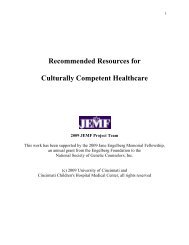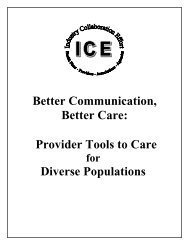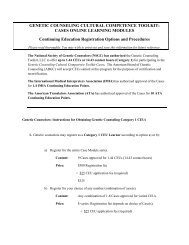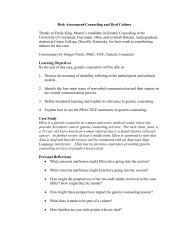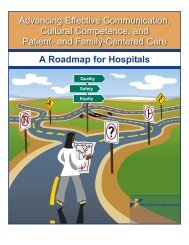Breaking Bad News PPT[1] - Genetic Counseling Cultural ...
Breaking Bad News PPT[1] - Genetic Counseling Cultural ...
Breaking Bad News PPT[1] - Genetic Counseling Cultural ...
You also want an ePaper? Increase the reach of your titles
YUMPU automatically turns print PDFs into web optimized ePapers that Google loves.
<strong>Breaking</strong> <strong>Bad</strong> <strong>News</strong><br />
© 2010 Nancy Steinberg Warren, MS, CGC, all rights reserved.
Learning Objectives<br />
Students will be able to<br />
Define bad news<br />
Describe Buckman’s 6 step protocol for<br />
breaking bad news<br />
List potential client responses to bad news<br />
Apply these concepts to genetic counseling<br />
demonstrated through role plays and clinical<br />
practice<br />
© 2010 Nancy Steinberg Warren, MS, CGC, all rights reserved.
What is <strong>Bad</strong> <strong>News</strong><br />
Give an example from clinical or personal<br />
experience<br />
© 2010 Nancy Steinberg Warren, MS, CGC, all rights reserved.
Defining <strong>Bad</strong> <strong>News</strong><br />
“Information likely to drastically alter a<br />
patient’s view of his or her future.”<br />
(Buckman, 1992)<br />
“…situations where there is either a feeling<br />
of no hope, a threat to one’s mental or<br />
physical well-being, a risk of upsetting an<br />
established lifestyle, or where the<br />
message given conveys fewer choices in<br />
his or her life…”<br />
© 2010 Nancy Steinberg Warren, MS, CGC, all rights reserved.
What is <strong>Bad</strong> <strong>News</strong><br />
Results in a cognitive, behavioral or<br />
emotional impact that persists for some<br />
time after the news is received<br />
May be perceived as bad from the<br />
perspective of the giver, the receiver, or<br />
both<br />
perception of severity varies for each person<br />
one cannot estimate the impact of bad news<br />
until the recipient’s expectations and<br />
understanding is determined<br />
© 2010 Nancy Steinberg Warren, MS, CGC, all rights reserved.
Why is <strong>Breaking</strong> <strong>Bad</strong> <strong>News</strong> Difficult<br />
What are your thoughts<br />
© 2010 Nancy Steinberg Warren, MS, CGC, all rights reserved.
Why is <strong>Breaking</strong> <strong>Bad</strong> <strong>News</strong> Difficult<br />
Concern for how the news will affect client<br />
Client’s fears of social stigma and impact of<br />
disability and illness<br />
Fear of client’s reaction to the news<br />
Uncertainty in dealing with intense emotional<br />
response<br />
Fear of being blamed<br />
Fear of how this affects you/expressing emotion<br />
Challenge of delivering the news appropriately<br />
and sensitively for this client<br />
Not wanting to take away hope<br />
© 2010 Nancy Steinberg Warren, MS, CGC, all rights reserved.
The way bad news is given is important,<br />
according to Buckman<br />
“…some unhappiness is caused by what<br />
the client is hearing, but dissatisfaction<br />
with the way they hear it is most<br />
commonly caused by:<br />
The doctor not listening or not appearing to<br />
listen<br />
The doctor using jargon<br />
The doctor talking down to the patient”<br />
© 2010 Nancy Steinberg Warren, MS, CGC, all rights reserved.
Words of Wisdom: Buckman<br />
“An expert in breaking bad news is not<br />
someone who gets it right every time—he<br />
or she is merely someone who gets it<br />
wrong less often, and who is less flustered<br />
when things do not go smoothly.”<br />
© 2010 Nancy Steinberg Warren, MS, CGC, all rights reserved.
HOW TO BREAK BAD NEWS:<br />
A GUIDE FOR HEALTH CARE<br />
PROFESSIONALS<br />
Robert Buckman, M.D.<br />
The Six-Step Protocol<br />
© 2010 Nancy Steinberg Warren, MS, CGC, all rights reserved.
Advance Preparation<br />
Review all relevant clinical information<br />
Be prepared to share pertinent lab reports<br />
Mentally rehearse how you will deliver the<br />
bad news. Think about specific words or<br />
phrases to use and to avoid.<br />
Arrange for adequate time, space, with no<br />
interruptions<br />
Think about how the client will react and<br />
how you can respond<br />
© 2010 Nancy Steinberg Warren, MS, CGC, all rights reserved.
Advance Preparation<br />
Use<br />
“I’m sorry to have to<br />
tell you this”<br />
“I know this is not<br />
good news for you”<br />
“I was hoping for a<br />
better result”<br />
Avoid<br />
“You knew….We talked<br />
about…this was a<br />
possibility”<br />
“I see this all of the<br />
time”<br />
“There’s always next<br />
time”<br />
© 2010 Nancy Steinberg Warren, MS, CGC, all rights reserved.
Step 1: Start off well<br />
Get the physical context right:<br />
<br />
<br />
<br />
<br />
<br />
Where and to whom are you speaking<br />
Arrange for important family members to be present<br />
In person; not over the telephone<br />
In a separate, private room<br />
Take control of the situation to help you and the family<br />
to be more relaxed<br />
© 2010 Nancy Steinberg Warren, MS, CGC, all rights reserved.
Step 1: Start off well<br />
<br />
<br />
Maintain control of the immediate environment, to the extent<br />
that you can.<br />
“I know it’s a bit of a walk, but it’ll be much easier to talk if we<br />
can sit down.” You’ll find it easier to ask questions if we find<br />
somewhere quiet and private.”<br />
draw curtains<br />
close the door<br />
sit down (and not behind a big desk)<br />
© 2010 Nancy Steinberg Warren, MS, CGC, all rights reserved.
Step 1: Start off well<br />
If you must stand, lean against the wall; it gives<br />
the illusion that you are there for them and not<br />
about to exit until both you and they are finished<br />
Be sure you know to whom you are speaking-<br />
ASK!<br />
Obtain permission--with whom can you discuss<br />
the diagnosis<br />
© 2010 Nancy Steinberg Warren, MS, CGC, all rights reserved.
Step 1: Start off well<br />
Be respectful:<br />
patient covered up<br />
use appropriate names<br />
keep a comfortable distance<br />
pay attention to your own body language<br />
make eye contact<br />
© 2010 Nancy Steinberg Warren, MS, CGC, all rights reserved.
Step 1: Start off well<br />
Start the conversation with a question to<br />
assess the client’s state before launching<br />
into a sensitive conversation<br />
“How are you feeling right now”<br />
“How are things today”<br />
“Do you feel well enough to talk for a bit”<br />
© 2010 Nancy Steinberg Warren, MS, CGC, all rights reserved.
Step 1: Start off well<br />
If the need for the conversation is<br />
pressing:<br />
“I know you are not feeling well, but perhaps<br />
we could talk for a few minutes now, then I<br />
could come back tomorrow”<br />
© 2010 Nancy Steinberg Warren, MS, CGC, all rights reserved.
Step 2: Find out how much the patient<br />
knows<br />
Find out what the patient knows about the impact<br />
of the illness on his or her future<br />
“Before you tell, ask”<br />
<br />
<br />
<br />
<br />
“What have you made of the diagnosis so far”<br />
“Have you been very worried about the pregnancy”<br />
“Have you been thinking that this might be something<br />
serious when the test was repeated”<br />
“Can you tell me what you remember about why the<br />
amniocentesis test was recommended”<br />
© 2010 Nancy Steinberg Warren, MS, CGC, all rights reserved.
Step 2: Find out how much the patient<br />
knows<br />
Utilize your full concentration and listening<br />
skills<br />
Listen to the patient’s responses for:<br />
What is the patient’s understanding of the<br />
situation<br />
How much has she understood and how close<br />
to reality are her impressions<br />
Assess the style of the patient’s statementswhat<br />
words/vocabulary is she using/avoiding<br />
© 2010 Nancy Steinberg Warren, MS, CGC, all rights reserved.
Step 2: Find out how much the patient<br />
knows<br />
Take no notice of the patient’s profession:<br />
“I know you are a nurse/doctor, but I hope<br />
you won’t mind if I start at the beginning and<br />
if I’m covering old ground you’ll tell me.”<br />
© 2010 Nancy Steinberg Warren, MS, CGC, all rights reserved.
Step 2: Find out how much the patient<br />
knows<br />
The emotional content of the patient’s<br />
statements, verbal and nonverbal<br />
At this point, you have minimized discomfort<br />
of both yourself and the patient<br />
The patient knows you are trying to listen and<br />
that you are interested in what she thinks is<br />
going on<br />
© 2010 Nancy Steinberg Warren, MS, CGC, all rights reserved.
Step 3: Finding out how much the<br />
patient wants to know<br />
How much information is desired; at what<br />
level does the family want to know what’s<br />
going on<br />
Several studies indicate that more distress is<br />
caused by not discussing information than by<br />
discussion<br />
Asking patients what they want allows them<br />
to exercise their preferences<br />
© 2010 Nancy Steinberg Warren, MS, CGC, all rights reserved.
Step 3: Finding out how much the<br />
patient wants to know<br />
Phrasing the question:<br />
“I have the results of your genetic testing, but<br />
I just want to make sure that this is still<br />
information you want to know.”<br />
“Are you the kind of person who likes the full<br />
details of the diagnosis, or would you prefer<br />
just to hear about the options available to<br />
you”<br />
© 2010 Nancy Steinberg Warren, MS, CGC, all rights reserved.
Step 3: Finding out how much the<br />
patient wants to know<br />
You want to get a clear invitation from the<br />
patient to share information.<br />
If the patient expresses a preference not<br />
to discuss the information, leave the<br />
option open for later discussion.<br />
“That’s fine. If you change your mind or you<br />
want any questions answered, just call me.”<br />
“I’ll be sure to check back with you in a few<br />
days.”<br />
© 2010 Nancy Steinberg Warren, MS, CGC, all rights reserved.
Step 4: Sharing the Information<br />
The informing interview has two parts,<br />
aligning and educating:<br />
Aligning<br />
start from the patient’s starting point<br />
line up the information you wish to impart on the<br />
patient’s knowledge baseline<br />
You have already heard how much the patient<br />
knows about the situation, and the vocabulary<br />
she uses to discuss it<br />
Gives the patient confidence that her view of<br />
the situation has been heard and is being<br />
taken seriously<br />
© 2010 Nancy Steinberg Warren, MS, CGC, all rights reserved.
Step 4: Sharing the Information<br />
Educating: the process by which the<br />
professional brings the patient’s<br />
understanding of the medical situation<br />
closer to the facts<br />
Give a warning shot<br />
Give information in small chunks<br />
Avoid using jargon<br />
Check reception frequently<br />
Reinforce and clarify<br />
Monitor your own communication level<br />
Listen for the patient’s concerns<br />
Engage in “therapeutic dialogue”<br />
© 2010 Nancy Steinberg Warren, MS, CGC, all rights reserved.
Step 4: Sharing the Information<br />
Give a warning shot<br />
Providing some warning that bad news is<br />
coming may lessen the shock that can<br />
follow the disclosure of bad news<br />
“Unfortunately, I have some (unexpected)<br />
(bad) news to tell you.”<br />
“I’m sorry, but the test results are not<br />
what you were hoping for…”<br />
“I’m sorry to tell you…”<br />
© 2010 Nancy Steinberg Warren, MS, CGC, all rights reserved.
Step 4: Sharing the Information<br />
If there is apparently a large gap between the<br />
patient’s expectations and the reality of the<br />
situation, you can facilitate the patient’s<br />
understanding by giving a warning that things<br />
are more serious than they appear to the<br />
patient.<br />
“Well, the test results that I received indicate<br />
that the situation does appear to be more<br />
serious than Dr. Smith implied.”<br />
© 2010 Nancy Steinberg Warren, MS, CGC, all rights reserved.
Step 4: Sharing the Information<br />
<br />
Preceding the warning shot, a narrative of events can be an<br />
extremely useful technique, as it is easy to follow and helps the<br />
patient to frame her questions as the story continues<br />
“When you visited Dr. M at the beginning of the pregnancy,<br />
blood was taken and Dr. M ordered a lot of tests on it. One of<br />
the tests that was done showed... Then the nurse scheduled<br />
you for an amniocentesis that you had in January. I have the<br />
results of the baby’s chromosome results from the<br />
amniocentesis test, and I am sorry to tell you that the results<br />
are not what we were hoping for….”<br />
Gives the client time to focus and prepare for the news<br />
“The test showed that there is an extra chromosome 21 in<br />
every cell…which means the baby has Down syndrome.”<br />
© 2010 Nancy Steinberg Warren, MS, CGC, all rights reserved.
Step 4: Sharing the Information<br />
Give most of the critical information in 2-3<br />
sentences<br />
Use limited genetic/medical terminology<br />
Allow time for silence-often means that the client<br />
is thinking or feeling something important<br />
Allow time for tears; offer tissue to convey the<br />
message that crying is allowed<br />
Touch the client’s shoulder/arm or move closer to<br />
her to imply that it is OK to show emotion<br />
Avoid the urge to talk to overcome your own<br />
discomfort<br />
© 2010 Nancy Steinberg Warren, MS, CGC, all rights reserved.
Step 4: Sharing the Information<br />
Identify and acknowledge the client’s<br />
reaction<br />
Common reactions to bad news: despair,<br />
grief, depression, denial, anger<br />
“I know this isn’t what you wanted to hear.<br />
I wish the news (results; information)<br />
could have been better.”<br />
© 2010 Nancy Steinberg Warren, MS, CGC, all rights reserved.
Step 4: Sharing the Information<br />
Decide on your agenda: diagnosis, treatment<br />
plan, prognosis or support<br />
You should have some form of an agenda in mind.<br />
It is easiest to state the rough outline of the<br />
interview before beginning this part:<br />
<br />
<br />
“I’ll start off by telling you about the condition and the<br />
health effects for the baby, then we can discuss all of<br />
that and the future and anything else you wish. We<br />
don’t have to talk about everything today, though. Lets<br />
see how it goes; we can always meet again tomorrow,<br />
or next week.”<br />
Be aware that the client will not retain most of what is<br />
said after the initial bad news<br />
© 2010 Nancy Steinberg Warren, MS, CGC, all rights reserved.
Step 4: Sharing the Information<br />
Use English, not Medspeak<br />
triple screen, lethal, neurofibroma<br />
Check your communication level<br />
If the patient replies using a different<br />
vocabulary, try to adapt your language to the<br />
patient’s<br />
© 2010 Nancy Steinberg Warren, MS, CGC, all rights reserved.
Step 4: Sharing the Information<br />
Check reception frequently<br />
“Tell me, what you are thinking about all of<br />
this now”<br />
“Am I making sense”<br />
“Do you follow what I am saying”<br />
“What questions do you have”<br />
© 2010 Nancy Steinberg Warren, MS, CGC, all rights reserved.
Step 4: Sharing the Information<br />
Reinforce and clarify the information<br />
frequently<br />
Clarification: Make sure you both mean the<br />
same thing<br />
Get the patient to repeat the general drift<br />
of what you have been saying<br />
“Why don’t we talk about what you think about<br />
caring for a child with Down syndrome and<br />
what you think that means for you and your<br />
family.”<br />
© 2010 Nancy Steinberg Warren, MS, CGC, all rights reserved.
Step 4: Sharing the Information<br />
Repeat important points yourself<br />
“I know we talked about a lot of facts, so why<br />
don’t I summarize the pros and cons of both<br />
amniocentesis and CVS. I’ll write out a chart<br />
and you can have this paper and go over it at<br />
home if you want to. Don’t be afraid to call<br />
me tomorrow if you’d like me to review any<br />
part of it for you.”<br />
© 2010 Nancy Steinberg Warren, MS, CGC, all rights reserved.
Step 4: Sharing the Information<br />
Use diagrams and written messages<br />
Simple scribbles on the back of an envelope or<br />
scrap of paper<br />
Diagrams about the form of inheritance, how<br />
the translocation can result in unbalanced<br />
offspring, triplet repeat expansion ranges<br />
© 2010 Nancy Steinberg Warren, MS, CGC, all rights reserved.
Step 4: Sharing the Information<br />
Use any written or recorded material available<br />
<br />
<br />
brochures, resources: Be aware of their content<br />
“I’ve told you about all the important and common<br />
effects that occur in adults with tuberous sclerosis, but I<br />
want you to know that there can be other effects.<br />
They’re very rare, and you can read about them in this<br />
brochure, if you want to. Some people like to have the<br />
complete list of things that have been reported to occur<br />
and that’s why they have the full details in the pamphlet.<br />
I’ve told you about the common features of tuberous<br />
sclerosis, so if you don’t feel like you need more<br />
information about the rarer things right now, you can<br />
always look at the brochure at another time.”<br />
© 2010 Nancy Steinberg Warren, MS, CGC, all rights reserved.
Step 4: Sharing the Information<br />
Listen for the patient’s concerns<br />
In counseling a couple about Down syndrome<br />
newly diagnosed in their baby, the woman’s<br />
biggest concern may be the fear of her<br />
husband leaving her and the kids.<br />
© 2010 Nancy Steinberg Warren, MS, CGC, all rights reserved.
Step 4: Sharing the Information<br />
It is counterproductive to proceed<br />
according to your own agenda, ignoring<br />
the patient’s<br />
As you transmit information to the patient,<br />
you are also listening for the patient’s<br />
reaction and trying to elicit her agenda<br />
© 2010 Nancy Steinberg Warren, MS, CGC, all rights reserved.
Step 4: Sharing the Information<br />
Try to elicit the patient’s “shopping list” of<br />
concerns and anxieties<br />
hair loss from chemotherapy<br />
sexual implications of colostomy<br />
Listen for the buried question<br />
sexuality issues in Down syndrome<br />
Be prepared to be led<br />
You may draw a session to a close, and then<br />
find that the patient wants to start part of it<br />
again<br />
© 2010 Nancy Steinberg Warren, MS, CGC, all rights reserved.
Step 4: Sharing the Information<br />
Try to blend your agenda with the<br />
patient’s<br />
You are changing or accommodating to adapt<br />
to the patient’s point of view, and that sense<br />
of compromise will make the patient feel that<br />
you are interested in supporting her<br />
Therapeutic dialogue<br />
the professional listens to, hears, and responds<br />
to the patient’s reactions to the information<br />
© 2010 Nancy Steinberg Warren, MS, CGC, all rights reserved.
Step 4: Sharing the Information<br />
As you obtain the list of concerns from the<br />
patient, acknowledge the items on it and<br />
try to include them in the topics that you<br />
cover<br />
“Alzheimer’s occurs in older adults with Down<br />
syndrome, and because your father has<br />
Alzheimer’s, I know you are very worried<br />
about the possibility that the baby will develop<br />
Alzheimer’s when she is older. I will tell you<br />
everything I know about this, but can we first<br />
talk about the health effects of Down<br />
syndrome that need some attention in the first<br />
few weeks and months of her life”<br />
© 2010 Nancy Steinberg Warren, MS, CGC, all rights reserved.
Step 5. Responding to the patient’s<br />
feelings<br />
Identify and acknowledge the patient’s<br />
reaction, distinguishing adaptive from<br />
maladaptive reactions<br />
humor/guilt<br />
crying/collapse<br />
realistic hope/unrealistic hope<br />
disbelief, shock, denial, displacement, fear and<br />
anxiety, anger and blame, guilt, hope, despair,<br />
depression, over dependency, relief,<br />
bargaining<br />
© 2010 Nancy Steinberg Warren, MS, CGC, all rights reserved.
Step 5. Responding to the patient’s<br />
feelings<br />
Identify and acknowledge the clients reaction<br />
Inquire about the patient’s emotional and<br />
spiritual needs, and support systems<br />
Identify patient’s coping strategies and reinforce<br />
them<br />
Offer realistic hope<br />
Avoid trying to be overly reassuring<br />
“The success or failure of the breaking bad news<br />
interview ultimately depends on how the patient<br />
reacts and how you respond to those reactions<br />
and feelings.”<br />
© 2010 Nancy Steinberg Warren, MS, CGC, all rights reserved.
Step 6. Planning and follow-through<br />
Planning for the future<br />
Demonstrate an understanding of the patient’s<br />
problem list<br />
Indicate you can distinguish the fixable from<br />
the unfixable. It is not useful to be<br />
unrealistically overoptimistic about the future<br />
Ask what the client will do after leaving the<br />
session<br />
© 2010 Nancy Steinberg Warren, MS, CGC, all rights reserved.
Step 6. Planning and follow-through<br />
Make a plan or strategy and explain it<br />
The management of the medical condition forms part<br />
of the support of the patient<br />
<br />
“When Joey is 6 weeks old, the plan for early intervention<br />
can begin. You will need to call the program this week in<br />
order to get him scheduled. Here is the phone #. If you<br />
have any problems, give me a call and I can help you with<br />
this.”<br />
<br />
“We’ll deal with each problem as it arises.”<br />
<br />
“Preparing for the worst doesn’t stop us from hoping for the<br />
best.”<br />
© 2010 Nancy Steinberg Warren, MS, CGC, all rights reserved.
Step 6. Planning and follow-through<br />
Make a contract<br />
<br />
“What questions would you like to ask me now”<br />
<br />
It is useful to tell patients that this is not the last chance to<br />
discuss any major issues, and to encourage them to jot<br />
down any other questions that occur on a piece of paper<br />
and to bring this with them to the next visit, or to call you.<br />
<br />
“Here is the phone # for Cardiology so you can get the<br />
echo done this week. You should hear from a mom from the<br />
Down Syndrome Association in a few days. I’ll also plan to<br />
touch base when you come to see Dr. xyz in two weeks. I’ll<br />
call you on Friday to see how you’re doing. If you want to<br />
talk anytime, just give me a call.”<br />
© 2010 Nancy Steinberg Warren, MS, CGC, all rights reserved.
<strong>Breaking</strong> <strong>Bad</strong> <strong>News</strong> on the Telephone<br />
Balance the need to provide basic information<br />
about the situation while avoiding extended<br />
counseling during the initial moments of shock<br />
Some patients may accept a brief phone<br />
conversation with the initial statement of bad<br />
news, a statement of sympathy, and a f-up plan<br />
Some patients may attempt to take control of the<br />
situation (and their grief/pain) by trying to ask<br />
too many ’s<br />
Acknowledge the difficulty of waiting for a followup<br />
appt for extended discussion<br />
Gently, but firmly, limit the extent of the<br />
conversation<br />
© 2010 Nancy Steinberg Warren, MS, CGC, all rights reserved.
The Counselor’s Needs<br />
Attend to your own needs during and after<br />
the delivery of bad news<br />
These experiences trigger powerful<br />
feelings<br />
With whom can you discuss the<br />
experience (peer supervision)<br />
© 2010 Nancy Steinberg Warren, MS, CGC, all rights reserved.


![Breaking Bad News PPT[1] - Genetic Counseling Cultural ...](https://img.yumpu.com/35003134/1/500x640/breaking-bad-news-ppt1-genetic-counseling-cultural-.jpg)






